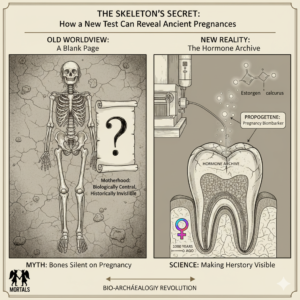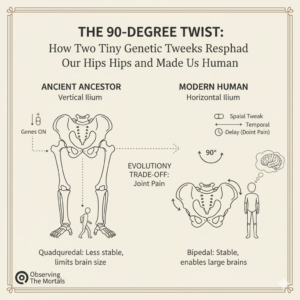The popular image of the Neanderthal is one of a brutish, primitive creature, confined to the cold caves of Ice Age Europe. But what if this picture is completely wrong? What if they were, in fact, sophisticated and resilient long-distance travelers who built a vast, interconnected world spanning continents? A groundbreaking new study of a single fossil bone from Crimea, powered by cutting-edge genetic analysis, provides the strongest evidence yet for this revolutionary new vision, linking Neandertals in Eastern Europe to their kin 3,000 kilometers away in the heart of Siberia.
The Information Box
Syllabus Connection:
- Paper 1: Chapter 1.6 (Phylogenetic Status… of Human Fossils: Neandertals), Chapter 1.4 (Human Evolution), Chapter 9.4 (Human DNA profiling), Chapter 1.8 (Prehistoric Archaeology: Tool Types)
Key Concepts/Tags:
- Neanderthal, Ancient DNA (aDNA), Mitochondrial DNA (mtDNA), Migration, Paleoanthropology, Crimea, Altai Mountains, Protein Analysis
The Setting: Who, What, Where?
This case study is centered on a single, 45,000-year-old fossil bone fragment (likely from a leg) that was excavated decades ago at the Starosele rock-shelter in Crimea (Eastern Europe). The challenge was that the bone was too fragmented to be identified by its shape alone. A team of researchers, including archaeologist Emily Pigott, first used protein analysis (paleoproteomics) to scientifically confirm the bone belonged to a Neandertal. They then successfully extracted mitochondrial DNA (mtDNA), which is passed down from mother to child. The breakthrough came when they compared this genetic sequence to other known Neanderthal genomes.
The Core Argument: Why This Study Matters
This study provides the first direct, high-resolution proof of the vast scale of Neanderthal mobility, fundamentally changing our understanding of their world.
- Direct Genetic Proof of Long-Distance Migration: The key finding is that the Crimean fossil’s mtDNA is extremely closely related to the mtDNA of Neanderthals found 3,000 kilometers east in the Altai Mountains of Siberia. This isn’t a vague, ancient ancestral link; it’s a “cousin-level” connection that proves these populations were in direct contact, moving vast distances and sharing genetic lineages.
- A Vast, Interconnected Neanderthal “Mega-Population”: This shatters the old model of Neanderthals living in small, isolated, and static groups. The genetic data, supported by similar stone tool-making styles found in both regions, suggests a vast, interconnected “mega-population” that stretched across Eurasia. They were not just surviving in isolated pockets; they were actively migrating, adapting, and carrying their culture and genes across continents.
- Explaining the Capacity for Interbreeding: This discovery helps solve a major piece of the human evolution puzzle. We know Neanderthals interbred with Homo sapiens and Denisovans (as seen in the famous “Denny” fossil, a hybrid girl found in the Altai). This high degree of mobility explains how these encounters were possible, as Neanderthal groups were actively moving into the same Asian territories inhabited by other hominin groups.
The Anthropologist’s Gaze: A Critical Perspective
- The Power of New Molecular Methods: This case study is a perfect example of how new scientific methods are unlocking secrets from old, “unusable” museum collections. The fossil was visually unidentifiable. It was protein analysis that gave it an identity and ancient DNA that told its story. This highlights a major shift in paleoanthropology, where molecular data is now as important, if not more important, than the physical shape of a fossil.
- Climate-Driven Adaptation (Cultural Ecology): The researchers propose that these massive treks were not random walks but were likely enabled by warmer climatic periods that made the vast steppes of Central Asia more habitable. This is a classic example of ecological anthropology, showing how environmental change (a warming climate) directly facilitates a major cultural and behavioral shift (long-distance migration).
- The Story Told by mtDNA: A critical scientific point is that this study used mitochondrial DNA (mtDNA). Because mtDNA is passed down only from the mother, this discovery tells a specific and powerful story about the migration of female Neandertal lineages across thousands of kilometers. To get the complete picture of the whole population, further research would be needed to extract and analyze the much rarer nuclear DNA, which is inherited from both parents.
The Exam Angle: How to Use This in Your Mains Answer
- Types of Questions Where It can be Used:
- “Discuss the geographical distribution and adaptive strategies of Neanderthals.”
- “How have new scientific methods like ancient DNA analysis revolutionized the field of paleoanthropology?”
- “Analyze the evidence for migration and interbreeding among Neandertals, Denisovans, and Homo sapiens.”
- Model Integration:
- On Neandertal Mobility: “Our understanding of Neandertal mobility has been transformed by genetics. A 2025 study of a 45,000-year-old Crimean fossil provided a direct mitochondrial DNA link to Neanderthals in the Altai mountains, 3,000 km away, proving the existence of vast, trans-continental migrations.”
- On New Methods: “New molecular methods are unlocking old fossils. A bone fragment from Starosele, Crimea, too small to be identified by eye, was first confirmed as Neanderthal using protein analysis and then, through aDNA, was genetically linked to Siberian populations, rewriting our map of the Neanderthal world.”
- On Interbreeding: “The high degree of mobility shown by the 2025 Crimean fossil study helps explain how interbreeding events occurred. These long-distance treks across Asia placed European Neandertal populations in the same territories as Denisovans and migrating Homo sapiens, facilitating gene flow.”
Observer’s Take
This small, fragmented bone from a Crimean cave has completely redrawn the boundaries of the Neanderthal world. It shatters the lingering 19th-century stereotype of a brutish, static caveman, replacing it with a new, scientifically backed image: that of a resilient, adaptive, and sophisticated long-distance traveler. This discovery is a powerful reminder that the Earth was once populated by multiple, intelligent human groups who, like us, were explorers. They were not isolated failures waiting for extinction but a vast, interconnected network of human relatives whose ancient journeys across continents set the very stage for the rest of the human story.
Source
- Title: DNA reveals Neanderthals traveled thousands of kilometers into Asia
- Author: Bruce Bower
- Publication: Science News
- Original Research: Proceedings of the National Academy of Sciences (PNAS)





